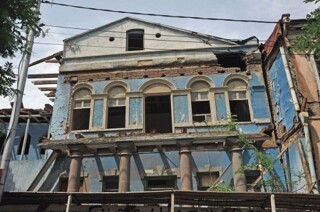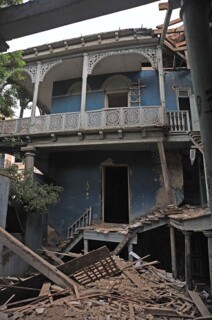Not Demolition, ‘Research’
Gillian Darley
They are pulling down the 19th-century Lermontov House in Gudiashvili Square in Tbilisi. The historical association Tiflis Hamqari have been protesting against the demolition since Sunday, sounding off with whistles and horns and holding placards – ‘If you destroy this building you destroy us’ – while the process of stripping out fretwork balconies and roof timbers, smashing stair banisters and ripping out floorboards goes on behind them. The work is being carried out on behalf of the Georgian office of an Austro-German developer, Magnat, whose head office is in Frankfurt.
The company argues that they are conducting ‘research’, not demolition (for which there is no official consent) but the architect in charge, interviewed on TV as it was going on, found it hard to explain away the mountain of unmarked debris, the broken floorboards, banisters and wooden friezes and cornices. The stucco would be the next feature to go, he said. Asked how much, he replied: ‘All.’ Meanwhile the roofing was being removed but, caught on camera, it was brought back to the site.
The process is well rehearsed by now, according to the protesters (and evident to any visitor with a half-open eye). Historic, nominally protected buildings are left vulnerable to the elements, roofless and with leaking pipes. Nearing collapse, they are demolished for safety reasons. This allows for reconstruction around a concrete shell with pastiche ‘historic’ detail appended, the end result (usually having sprouted a mansard roof) amounting to a far greater square footage.

